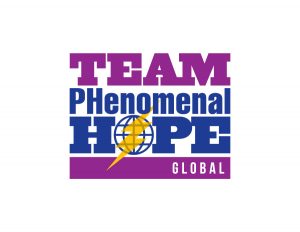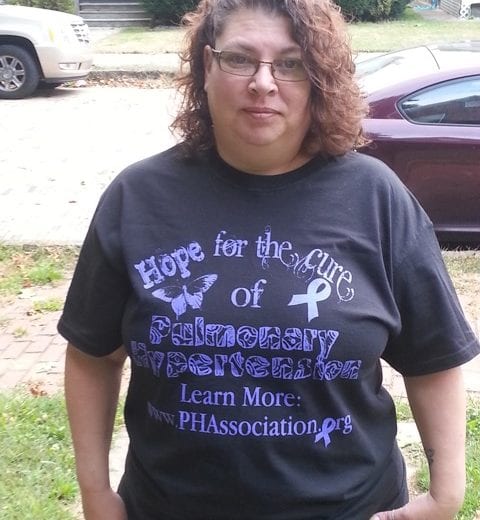The most difficult part about getting diagnosed with ANY type of disease I would say is, hearing you actually have it. Especially if you never even heard of it before today's date of being diagnosed.
I mean, how do you deal with learning about something that barely anyone knows about let alone this doctor who just said you have it but he can't treat you because; "he doesn't know enough about it." WHAT!? But you just told me I have it! How can you sit there and tell me I have something but you have no idea how to treat me for it. Here comes the downward spiral.
So you were just diagnosed with Pulmonary Hypertension, what do I do now? I know what I did, I went into denial. Nope, not me, I can't have it. I'm healthy, just short of breath when walking stairs. I don't have this, you are crazy. I know what this disease is, I've seen it first hand, live it first hand as a caregiver. This IS NOT ME! So I go to the Specialist, get the Right Heart Cath. done and I still am in denial. It doesn't matter what he says, what the test says, why oh why are you insisting that I have this. Reality sets in when I am told; "No traveling, so exercise, no lifting/pushing over 5-10 pounds, no more WORK…WHAT? I am only 40 you can not be serious. He said, “I am very serious. Your pressures are very high and you are in what we consider to be severe PH status. Without getting it under control you are at risk of dying.” WHAT? Seriously you are killing me here, don't tell me I can't work, and I can't travel, what the hell kind of life is that? Grrr, who is he to tell me to put my life on hold.
Yes, you guessed it, here comes the anger. Not just any anger. I am talking full blown, circuit frying anger.
So now I have decisions to make as to what medications to take. I AM NOT and WILL NOT go on any IV or SUB Q medications. If it is not oral to begin with, I am not doing it, bottom line. He loved how adamant I was in my decision making and asked my viewpoints as to why. I travel, I hike, I swim, and I do not want to hinder my abilities as our summers are spent swimming when the weather is nice. He said understandable. I said, I do not want the pain and side effects my mother goes through, I’m a chicken shit to poke myself….But you have tattoos…those are different than pinching yourself and having the pain to go with it, as well as side effects. A tattoo you get inked it stops hurting you move on. Anyway…He wanted to put me on the study drug program for Adcirca and Letairis, I denied immediately. Not that I didn’t want to be a part of a study, but because I already knew the medicines are BOTH approved from the FDA and this was to see if they were compatible with one another together. Still not guaranteeing me that I would get both at the time or one and a placebo, I denied and said…start me on something that is already approved and we know I am getting the drug and not a placebo, I want under control NOW not months from now. So, June 24 we did the 6 MWT and I failed miserably, only got to 12 laps, 256 meters or 841 feet, because they stopped me for my heart rate going to 243, but hey my sats (saturation) stayed at 95%. July 17, 2012 I did another RHC to see if the CCB and HCTZ was working, pressures came down some but not the PA Pressures. So August 17, 2012 I began my first pathway of Adcirca. I had major headaches from it, so I started to take the pill at night. Of course you start out with 1 ~ 20 mg tablet for the first week, then week two you start 2 ~ 20 mg tablets for treatment.
Anyway, this isn't about me, its about Living with PH and how to deal with it. So let's move on.
Here starts the “NEW” Normal
Learning how to live a "New" Normal and leaving your old life behind. It isn't easy but it is doable.
The main thing is to have a positive attitude, no matter what the circumstance is that you are facing. The biggest thing to overcome was eating out as often as I use to do. I don't mean a regular restaurant either, I am talking Fast food. Never really looked at the labeling because food was food, oh how wrong of a mindset was that. You learn fast, sometimes, not fast enough, but you learn. I'm almost 6 years into this darn disease and I'm still learning.
We have to learn to lower our salt intake, our fluid intake, what veggies are high in water, or some have to worry about how rich in vitamin K the produce is. Watch, watch, watch. Hello, this isn't as easy as you think it is. The water content in some fruits and veggies are higher that the item itself. For instance, who doesn't love them some good old asparagus? Did you know that 1 spear, just 1 is almost 2 Tablespoons of water! Also, it is a natural Diuretic, so if you are on diuretics watch how much you eat so you don't get leg cramps!!! But its great for the 💜. 1 Cup of cucumbers sliced is a 1/2 cup of water! 1 medium tomato is a 1/2 cup of water. 1 cup of watermelon is 1/2 cup of water. A FULL watermelon that is about 15" long is 17.5 cups of water! GO FIGURE, the things that are suppose to be good for a persons health actually hinders mine because I have to watch what I eat and how much of it so I am not causing myself to swell with excess water weight. UGH. Oh yes, because too much salt and too much fluid can make you retain fluid, and can cause Heart failure. Did you know that?
Mood swings ~ Do not get me started. We have our good days and we have our bad days and then we have our really bad days to where we want nothing to do with anyone and lock ourselves away in our own little world. Why? who knows! It could be the medications, it could be depression, it could be just about anything but it is there. Forgive us when we lash out, for it isn't easy being sick and trying to be our normal selves when we don't even know what normal is anymore.
Lets walk through a BAD PH DAY
Wake up and you are swelled from too much water retention. Heart is racing, shallow breathing because its really hard to catch your breath, and you just woke up. Chest feels like you have an elephant sitting in the middle of it and you are being squeezed by a vice in the middle of your chest. So here goes a double dose of diuretics to get the water off today. The bathroom is going to be our best friend. Many of us have an IV medication, which not only has you going to the bathroom more times than necessary, and not just for the normal bathroom run, but it also comes with sleepiness and a rash. So no matter how much sleep you get, they are still tired. Doesn't sound pleasant does it? Try living with it. Everyone thinks that oh, you just have high blood pressure, that is so controllable you only have to watch what you eat, nothing more serious than that, why are you making such a big deal about it. NO, it isn't the same. The high blood pressure we have affects our lungs and heart and is totally different than regular hypertension of blood vessels. Regular Hypertension can not be felt, Pulmonary Hypertension is felt in more ways than one.
The worst part of this disease, I feel, is not knowing when I am going to be sick. I mean, one minute I am fine, getting ready to go out and enjoy time with family and all of a sudden I start getting hot flashes, I'm dizzy, nauseated and my breathing is horrible. I don't want to cancel, but I don't want to spend my night in the hospital either in the event I pass out on you all and you have no clue what to do to help me. I remember I was at my nieces graduation party. I showed up before it started and helped to decorate. Once everyone started showing up and we ate the fun was suppose to begin. Not for me, I started breaking out in red splotches. Now mind you I wasn't in the sun, I tried to stay in the pavilion as much as I could. I broke out in this rash and everyone was like Jan, are you ok you are all red and splotchy? I said yes its just my medication, I am fine. No, I wasn't fine. I then began getting hot flashes and heart palpitations and I was nauseated. Needless to say, I had to cut my fun short because my PH decided to flare its ugly head at the most inopportune time, when I was having fun. So please, if we cancel last minute, forgive us as we have no control as to when symptoms will arise, we don't do it on purpose.
Lets walk through daily living with chores
Take your time! Time is all you have and it doesn't have to be breathless. When doing dishes, keep a stool that is sink level or stove level in there with you. If you don't have one, buy one! Sit while you do dishes or preparing your foods for cooking.
Bathing and showering ~ Why reach when you can sit and relax while cleaning yourself. Get a shower chair and a removable shower head.
Laundry ~ use smaller baskets that are lighter like the fishnet baskets. Put enough clothing in there that won't cause you to be so short of breath carrying it. I have three sizes I use and the larger one's I have my husband to thank, as he carries those and does that round of clothing, where I will do the small baskets.
Reaching, stretching, bending. Get a reacher rod or a step stool. Not only does it help you prevent yourself from bending over too much but it helps keep arm strength 😊
How to keep your activity without being discouraged
One step at a time. Every person is different one from another. The best advice you will hear from anyone dealing with this disease, walk. The more you walk, the better you feel, no matter how far you walk. Today you could walk from the couch to the kitchen and back, you walked. Tomorrow you walk from the couch to the kitchen to the sun-porch, back to the couch, you walked. The next day, go outside, go off your porch, back up your porch back to your couch. You see what you are doing? You are building stamina and strength. The more you walk the further you go. The further you go, the better you feel. Just because we are sick with this disease doesn't mean we have to stop doing. Yes, it is hard, but again, we can do it. We cannot be afraid to continue living.
How can we be happy
Life is what we make of it! You can choose to let this disease eat you up inside OR you can choose to control the disease and not let it define you, as a person. We only live once. NO-ONE knows the day or time in which our life will end, so why not live it to the best of our ability, the best that we possibly can? To our fullest and happiest. No, I'm not saying party hardy. I'm saying smell the roses, not the coffee. Unless you are a coffee drinker 😀Put your hand over your heart, do you feel that? Its still beating! We are blessed to be alive another day, sure we are sick, but we are still here to phight another day.
If you have a topic you would like addressed, please comment and let me know. I will gladly take the time to write a blog about it.
Thanks for reading today's episode. Stay tuned for tomorrow when we talk RARE DISEASE DAY 😊💜









